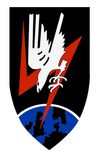Night Fighter Squadron 6
|
Night Fighter Squadron 6 |
|
|---|---|
|
The uniform squadron coat of arms of all night fighter squadrons. It shows an eagle plunging down from the night sky with red lightning on England. |
|
| active | January 1, 1943 to the end of April 1945 |
| Country |
|
| Armed forces | Wehrmacht |
| Armed forces | air force |
| Branch of service | Air force |
| Type | Jagdgeschwader |
| structure | Squadron staff and 4 groups |
| Insinuation | 7th Hunting Division |
| equipment | Bf 110 , Ju 88 G |
The Nachtjagdgeschwader 6 was a squadron of the German Air Force in World War II , which was primarily set up and used for night hunting .
Lineup
The IV. Group of the future Nachtjagdgeschwader 6 already flew missions in Romania under this name since June 1943 . On August 1, 1943, Group I was formed by renaming Group IV from Nachtjagdgeschwader 4 in Mainz . On September 15, 1943, the squadron staff was set up in Schleissheim and the second group was established in Neuburg an der Donau . On October 4, 1943, both the I. and II. Groups were placed under the squadron staff. On October 15, 1943, the 6th Night Fighter Wing was subordinated to the 7th Fighter Division. This emerged by renaming from the Jagdfliegerführer Süddeutschland . The list of the III. The group did not take place until May 10, 1944 when the II. Group of the 5 night fighter squadron was renamed . The squadron ID was 2Z.
Calls
1943 to 1944
The individual groups flew in the defense of the empire after their formation. The first group had been in Mainz since it was set up . She was later moved to Illesheim . Group II initially had its air bases in Schleissheim , Neuburg , Echterdingen and Kitzingen . During this time these groups flew day hunting missions in the air raid on Schweinfurt on October 14, 1943, as well as night hunting missions over Berlin . From April 1944 the II. Group was in Hagenau. On March 30 and April 27, 1944, the squadron shot down 14 aircraft.
After the Allied invasion of Normandy in June 1944, Group I was relocated to Holland , but was relocated back that same month and came to Neubiberg south of Munich , and later to Echterdingen- Hailfingen - Großsachsenheim- Schleissheim-Neubiberg. In the second half of 1944, the second group was stationed in Echterdingen-Mainz- Schwäbisch Hall - Ingolstadt .
The III. Group of the NJG 6, which had only been set up in Hagenau in May 1944 , was relocated to Hungary in June 1944 , where it was mainly used to repel Soviet and Anglo-American bombers. It also operated against agent and disruptive aircraft. In October the group returned to Germany and was relocated to Neubiberg and Bad Aibling .
A fourth group of NJG 6 was set up in Bucharest-Otopeni in May 1943 , parts of which were in other places in Romania and Bulgaria. She came back from Romania at the end of August 1944 and flew missions in the Schleißheim- Gerolzhofen- Kitzingen-Ingolstadt-Neubiberg-Bad Aibling area. In December 1944, the IV. Group was involved in major aerial battles. On December 6, 1944, she shot down six Lancasters in Gießen airspace . Parts of the squadron were involved in night battles on the western front at the turn of the year 1944/45 .
1945
In 1945 the entire squadron was deployed in defense of the Reich. On February 21, 1945, the squadron shot down 21 aircraft, on February 23, 14, on March 14, 16 and on March 16, 1945 20 aircraft. At the end of March 1945, the squadron staff and the four group staffs were disbanded. There remained a single group staff with four squadrons and one staff squadron. The last use of the NJG 6 is in the war diary for the night of June 26/27. Registered April 1945. On April 29, 1945, the parts remaining in Schleissheim surrender to the advancing US forces of the 45th Infantry Division without a fight. The units that had been relocated to Bad Aibling shortly before were disbanded there.
In another publication, the squadron structure NJG 6 is named as early 1945. Accordingly, the squadron, consisting of four groups, flew aircraft of the types Ju 88G and Bf 110 in early 1945 .
Squadron commodors
Between 1943 and 1945 the squadron was led by five Commodores . From August 10, 1943 by Major Fritz Schaffer , from February 10, 1944 to March 15, 1944 (fatally crashed over Echterdingen) by Major Heinrich Wohlers , from March 16, 1944 by Major von Reeken, from April 15, 1944 by Major Heinrich Griese and from September 13, 1944 until the dissolution of Lieutenant Colonel Herbert Lütje .
literature
- Wolfgang Dierich: The air force associations 1935-1945 - structure and short chronicles - a documentation. Motorbuch-Verlag Stuttgart 1976
- Eckard Sauer: Crash in the Kinzigtal - Aviation in the Hessian Kinzigtal from 1895 to 1950. Sauer-Verlag 2011, ISBN 978-3981441901
- Peter Schmitz, Klaus J. Thies, Günter Wegmann, Christian Zweng: The German Divisions 1939–1945 - Army, Land- Based Navy, Air Force, Waffen-SS / The Divisions 1–5. Volume 1, Biblioverlag 1993, ISBN 978-3764824211
- Werner Girbig: Start at dawn - A chronicle of the sinking of the German hunting rifle in the West in 1944/1945. Motorbuch-Verlag, Stuttgart 1992, ISBN 3-6130-1292-8 .
- Ernst Obermaier: The Luftwaffe Knight's Cross bearers 1939–1945. Volume I, fighter pilot, Verlag Dieter Hoffmann, Mainz 1966.
- War diary of the night fighter squadron 6th Federal Archives Freiburg i.Br., RL10 / 54.
